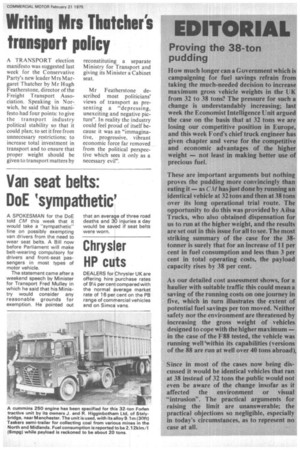Proving the 38-ton pudding
Page 17

If you've noticed an error in this article please click here to report it so we can fix it.
How much longer can a Government which is campaigning for fuel savings refrain from taking the much-needed decision to increase maximum gross vehicle weights in the 1:1( from 32 to 38 tons? The pressure for such a change is understandably increasing; last week the Economist Intelligence Unit argued the case on the basis that at 32 tons we are losing our competitive position in Europe, and this week Ford's chief truck engineer has given chapter and verse for the competitive and economic advantages of the higher weight — not least in making better use of precious fuel, These are important arguments but nothing proves the pudding more convincingly than eating it — as CM has just done by running an identical vehicle at 32 tons and then at 38 tons over its long operational trial route. The opportunity to do this was provided by Ansa Trucks, who also obtained dispensation for us to run at the higher weight, and the results are set out in this issue for all to see. The most striking summary of the case for the 38tonner is surely that for an increase of 11 per cent in fuel consumption and less than 3 per cent in total operating costs, the payload capacity rises by 38 per cent.
As our detailed cost assessment shows, for a haulier with suitable traffic this could mean a saving of the running costs on one journey in five, which in turn illustrates the extent of potential fuel savings per ton moved. Neither safety nor the environment are threatened hy increasing the gross weight of vehicles designed to cope with the higher maximum — in the case of the F88 tested, the vehicle was running well 'within its capabilities (versions of the 88 are run at well over 40 tons abroad).
Since in most of the cases now being discussed it would be identical vehicles that ran at 38 instead of 32 tons the public would not even be aware of the change insofar as it affected the environment or visual "intrusion". The practical arguments for raising the limit are unanswerable; the practical objections so negligible, especially in today's circumstances, as to represent no case at all.












































































































